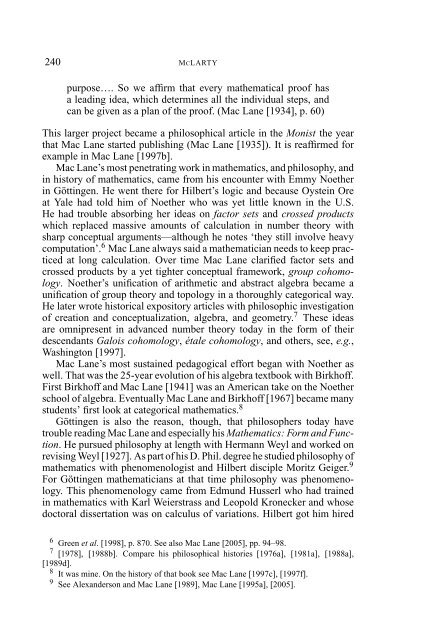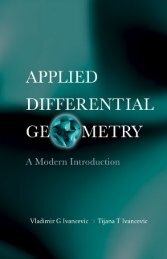PMeulogt MacLane
PMeulogt MacLane
PMeulogt MacLane
Create successful ePaper yourself
Turn your PDF publications into a flip-book with our unique Google optimized e-Paper software.
240 MCLARTY<br />
purpose…. So we affirm that every mathematical proof has<br />
a leading idea, which determines all the individual steps, and<br />
can be given as a plan of the proof. (Mac Lane [1934], p. 60)<br />
This larger project became a philosophical article in the Monist the year<br />
that Mac Lane started publishing (Mac Lane [1935]). It is reaffirmed for<br />
example in Mac Lane [1997b].<br />
Mac Lane’s most penetrating work in mathematics, and philosophy, and<br />
in history of mathematics, came from his encounter with Emmy Noether<br />
in Göttingen. He went there for Hilbert’s logic and because Oystein Ore<br />
at Yale had told him of Noether who was yet little known in the U.S.<br />
He had trouble absorbing her ideas on factor sets and crossed products<br />
which replaced massive amounts of calculation in number theory with<br />
sharp conceptual arguments—although he notes ‘they still involve heavy<br />
computation’. 6 Mac Lane always said a mathematician needs to keep practiced<br />
at long calculation. Over time Mac Lane clarified factor sets and<br />
crossed products by a yet tighter conceptual framework, group cohomology.<br />
Noether’s unification of arithmetic and abstract algebra became a<br />
unification of group theory and topology in a thoroughly categorical way.<br />
He later wrote historical expository articles with philosophic investigation<br />
of creation and conceptualization, algebra, and geometry. 7 These ideas<br />
are omnipresent in advanced number theory today in the form of their<br />
descendants Galois cohomology, étale cohomology, and others, see, e.g.,<br />
Washington [1997].<br />
Mac Lane’s most sustained pedagogical effort began with Noether as<br />
well. That was the 25-year evolution of his algebra textbook with Birkhoff.<br />
First Birkhoff and Mac Lane [1941] was an American take on the Noether<br />
school of algebra. Eventually Mac Lane and Birkhoff [1967] became many<br />
students’ first look at categorical mathematics. 8<br />
Göttingen is also the reason, though, that philosophers today have<br />
trouble reading Mac Lane and especially his Mathematics: Form and Function.<br />
He pursued philosophy at length with Hermann Weyl and worked on<br />
revising Weyl [1927]. As part of his D. Phil. degree he studied philosophy of<br />
mathematics with phenomenologist and Hilbert disciple Moritz Geiger. 9<br />
For Göttingen mathematicians at that time philosophy was phenomenology.<br />
This phenomenology came from Edmund Husserl who had trained<br />
in mathematics with Karl Weierstrass and Leopold Kronecker and whose<br />
doctoral dissertation was on calculus of variations. Hilbert got him hired<br />
6 Green et al. [1998], p. 870. See also Mac Lane [2005], pp. 94–98.<br />
7 [1978], [1988b]. Compare his philosophical histories [1976a], [1981a], [1988a],<br />
[1989d].<br />
8 It was mine. On the history of that book see Mac Lane [1997c], [1997f].<br />
9 See Alexanderson and Mac Lane [1989], Mac Lane [1995a], [2005].














